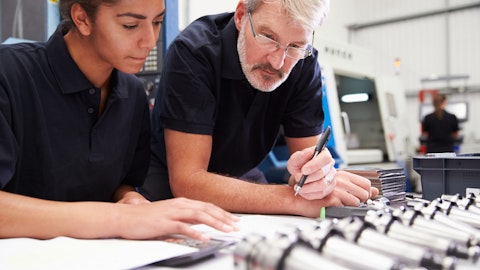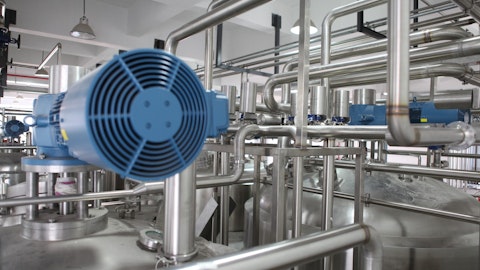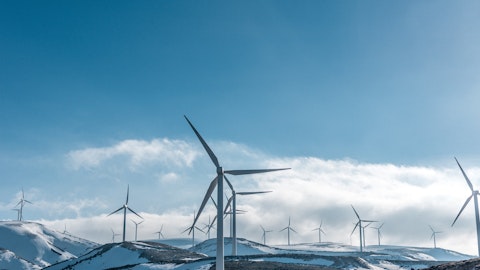Nigel Coe: So – good morning. I just wanted to talk about the — maybe just dig into the free cash flow the high single-digit free cash flow target. Can you maybe just talk about the free cash flow profile for Viessmann over the past several years? Obviously the growth has been very impressive. How is the free cash flow and the CapEx been trending? Maybe more importantly going forward what sort of CapEx investment you see required to sort of execute on this plan?
Patrick Goris: Yes, Nigel, Patrick here. So 2023 is still ongoing of course. But the two prior years, we believe that their free cash flow conversion has been in the mid-90s so 90% to 95% of net income. And so clearly we believe that there is a continued path to have a combined company that will be in about 100% free cash flow conversion range. As to CapEx investments clearly given the significant opportunity in heat pumps there have been heavy capital investments made by Viessmann, including in 2023. We have that dial into our numbers. And as I said, we expect going forward to continue to be a company that converts about 100% of net income into free cash flow.
Nigel Coe: Okay. That’s helpful. So let me just no extraordinary investment requirements. I mean, that’s what I hear from that but maybe just clarify that. But just do you want to pick up on Julian’s question about the format for the exits. Lots of questions about spin versus sale. Have you ruled out a spin at this point — the sale of Fire & Security the preferred option? And if you do sell it seems like you’ve got the capacity to buy more than the 50-odd million shares you’re issuing. So is that the upper limit of the buyback, or could that scale up?
Patrick Goris: It could scale up Nigel very clearly. And the first part of your comment was related to sale versus spin at the end of the day we’re evaluating the exits and ultimately we’ll pick whatever the exit is that delivers the best after-tax value for Carrier. And so whether that’s the sale versus spin that is what we’re focused on. And you’re right. If it is a sale we certainly see a path with expected proceeds that would enable us to buy more shares than the equivalent shares issued to Viessmann family.
Nigel Coe: Okay. Thanks very much.
Patrick Goris: Thank you.
Operator: Please standby for our next question. The next question comes from Jeffrey Sprague with Vertical Research. Your line is now open.
Jeffrey Sprague: Thank you. Good morning, everyone.
David Gitlin: Hey, Jeff.
Jeffrey Sprague: Just back to the deal math even, kind of, looking at the shares issue particularly given the $1 billion or so of cash you’re going to generate year-to-date, it actually looks to me like there is a path to first year all-in EPS accretion. I just wonder if there’s something in I don’t know how these guys report. It’s a private company, right? If we’re talking IFRS or something else. Is there just something in the way they report where we’ve got to normalize the numbers to conform to a Carrier basis or how would you respond to maybe the potential of upside to what you’re saying on accretion versus dilution?
Patrick Goris: Yes Jeff, we believe as we have shared on the slide that in year one, let’s assume 2024 that we will be modestly dilutive. That would include — and as I mentioned net income accretive adjusted net income accretive to the company, but given additional shares adjusted EPS modestly dilutive in year one accretive thereafter. Year one we do expect some integration or cost to implement some of the synergies. We think the cost to get to the synergies are relatively modest. We have $200 million of run rate synergies. We think the cost to get to these is maybe one-fourth of those. In addition to that, we have integration expenses that are probably about $100 million or so. We’ll see some of that in year one and so that may impact the EPS dilution as well that you calculate in year one.
Jeffrey Sprague: Okay. And then just on the exits Patrick, I think, you’ve appropriately said best after-tax path. Can you just give us a sense of what the tax basis is in the targeted companies? I would assume, it’s low and certainly some of them, but perhaps not. And you do have obviously some legacy liability in there right kind of the whole PFAS question. So how might you address that as part of the exit equation?
Patrick Goris: Yes. If there is a sales path or assuming a sales path there would be — we would expect there to be some leakage. We estimate maybe in the mid-teens given a modest tax basis in the assets. So that’s the first part of your question. I think when you were referring to some of the legacy liabilities I assume you were referring to ASSS Jeff?
Jeffrey Sprague: Yes. Yes.
Patrick Goris: Okay. So to the extent there is any ASSS liability at all, we believe it resides within Kidde-Fenwal. And just as we plan to exit Fire & Security, we plan to exit Kidde-Fenwal too and regardless of how we exit Fire & Security could spin well we expect to exit and at the end this to be a clean exit.
Jeffrey Sprague: Thank you.
Sam Pearlstein: Thank you, Jeff.
Operator: Please standby for our next question. The next question comes from Joe Ritchie with Goldman Sachs. Your line is now open.
Joe Ritchie: Thank you. Good morning. Congratulations, everyone.
David Gitlin: Good morning, Joe.
Joe Ritchie: Hi, Dave can you maybe just take a step back for us here and talk through how this deal came together? When we had dinner about a year ago you talked about wanting to scale into a European HVAC. I’m just also curious whether there’s any potential risk associated with another bidder coming in it doesn’t sound like it but just walk us through some of the history and that last piece of the question.
David Gitlin: Yes. We — Joe we have a pretty rigorous strat review process and it was clear from our very early days that when we spend we had two big gaps. We didn’t — we had VRF and we had European residential heating. So we wanted to start with VRF because of the underlying technology that it brings and we were fortunate with both Giwee and Toshiba to be able to enter that market. And then there was really all hands on deck on European residential heating. Clearly, no overlap no antitrust issues. And it was — if you look across our space and you did a chart showing growth rates predictable growth rates over the next 10 years in every single space in which we compete the single most attractive market is European residential heating and we don’t have a real presence there.
So we started meeting with effectively every single company across Europe. I had dinners what I would say virtually every CEO in the space and they’re a very, very impressive group. It’s just very, very difficult to break into that market because they’re traditionally multi-generation family-owned businesses. And Max and I had dinner about a year ago in Allendorf, Germany. And I think that we hit it off because we both had this common realization of the art of what’s possible. They truly are world-class. I mean they are the leader. If you could pick any company to come together with an European residential heating, it would clearly be Viessmann. They have the best brand, the best channel, the best technology, they are a very, very unique asset with great people.
And as we continue to develop the relationship, our whole premise was that one plus one has to be something greater than four. And if you look at the combination of Carrier and Viessmann Climate Solutions we said that we can do something that no other company in the world can do to create value for our people, our shareholders, our customers, and the planet. So, we probably had 15 dinners over the course of the last year as we continue to evolve what this relationship could be. I think the contract is very manages this idea of a potential interloper. Clearly, there’ll be a lot of people interested in Viessmann, but we’re just thrilled that Max had to share the same vision that we had in the art of what’s possible for the future.





